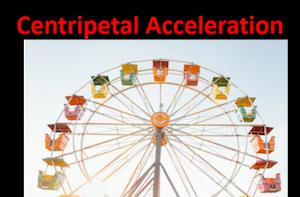Centripetal force is the force required to keep an object moving in a circular path. The word “centripetal” comes from the Latin words “centrum” meaning center and “petere” meaning to seek, so centripetal force is the force that “seeks the center” of a circle.
Table of Contents
Centripetal Force Formula
The formula for centripetal force is:
F = (mv2)/r
where:
- F is the centripetal force in Newtons (N);
- m is the mass of the object in kilograms (kg);
- v is the velocity of the object in meters per second (m/s);
- r is the radius of the circular path in meters (m)
Daily Life Examples of Centripetal Force
- When riding a bike or skateboard around a curved path, the centripetal force is provided by the friction between the wheels and the ground, allowing the rider to stay on the path.
- When swinging a yo-yo in a circular motion, the string provides the centripetal force needed to keep the yo-yo moving in a circular path.
- When twirling a hula hoop around your waist, your body provides the centripetal force to keep the hoop moving in a circular path.
- When riding a carousel or amusement park ride, the ride itself provides the centripetal force to keep riders moving in a circular path.
- When stirring a liquid in a circular motion with a spoon, the centripetal force is provided by the spoon, which pulls the liquid towards the center of the circle.
- When swinging a bucket of water in a circular motion, the centripetal force is provided by the weight of the water in the bucket, which pulls the bucket towards the center of the circle.
- When turning a corner in a car or bus, the centripetal force is provided by the friction between the tires and the road, allowing the vehicle to stay on the road and turn safely.
Centrifugal Force vs Centripetal Force
| # | Centripetal Force | Centripetal Acceleration |
| 1 | Centripetal force is a force that acts on an object moving in a circular path, and is directed towards the center of the circle. | Centripetal acceleration is the acceleration experienced by an object moving in a circular path, and is directed towards the center of the circle. |
| 2 | The formula for centripetal force is Fc = mv^2/r, where Fc is the centripetal force, m is the mass of the object, v is its velocity, and r is the radius of the circle. | The formula for centripetal acceleration is ac = v^2/r, where ac is the centripetal acceleration, v is the velocity of the object, and r is the radius of the circle. |
| 3 | Centripetal force is proportional to the mass of the object, the square of its velocity, and inversely proportional to the radius of the circle. | Centripetal acceleration is proportional to the square of the velocity of the object, and inversely proportional to the radius of the circle. |
| 4 | Centripetal force is measured in newtons (N). | Centripetal acceleration is measured in meters per second squared (m/s^2). |
| 5 | Centripetal force can be provided by various sources such as tension, friction, gravity, etc. | Centripetal acceleration is a result of the change in direction of the velocity of the object moving in a circular path. |
| 6 | Centripetal force is necessary to keep an object moving in a circular path. | Centripetal acceleration is necessary for an object to change its direction and move in a circular path. |
Simple Definition of Centripetal Force
Centripetal force is the force that acts on an object moving in a circular path, directed towards the center of the circle. It is necessary to keep the object moving in its circular path, and its magnitude is directly proportional to the object’s mass and the speed of its motion.
Uniform Circular Motion and Centripetal Force
Uniform circular motion is when an object moves in a circle at a constant speed. To keep it moving in that circular path, it needs a force called centripetal force. This force always points towards the center of the circle, and changes the object’s direction of movement to keep it on the circular path. The amount of centripetal force depends on the object’s mass, speed, and how big the circle is. Examples include a car going around a circular track, a satellite orbiting the Earth, and a ball on a string being swung around.
Solved Sample Problems
| Number | Problem Statement | Formula Used and Given Data | Calculation and Answer |
| 1 | A car of mass 1200 kg is moving around a circular turn of radius 50 m at a speed of 20 m/s. What is the centripetal force acting on the car? | Fc = mv^2/r, m = 1200 kg, v = 20 m/s, r = 50 m | Fc = (1200 kg)(20 m/s)^2 / 50 m = 9600 N |
| 2 | A student is twirling a 0.5 kg yo-yo on a string in a horizontal circle of radius 0.75 m. If the yo-yo is moving at a speed of 2 m/s, what is the centripetal force acting on it? | Fc = mv^2/r, m = 0.5 kg, v = 2 m/s, r = 0.75 m | Fc = (0.5 kg)(2 m/s)^2 / 0.75 m = 5.33 N |
| 3 | A roller coaster car of mass 500 kg is moving through a loop-the-loop track with a radius of 10 m at a speed of 25 m/s. What is the centripetal force acting on the car at the top of the loop? | Fc = mv^2/r, m = 500 kg, v = 25 m/s, r = 10 m | Fc = (500 kg)(25 m/s)^2 / 10 m = 31,250 N |
| 4 | A child is swinging a 2 kg bucket of water in a circular path with a radius of 0.5 m. If the bucket is moving at a speed of 1 m/s, what is the centripetal force acting on it? | Fc = mv^2/r, m = 2 kg, v = 1 m/s, r = 0.5 m | Fc = (2 kg)(1 m/s)^2 / 0.5 m = 4 N |
| 5 | An astronaut is in a space station orbiting Earth at a height of 500 km above the surface. If the space station is moving at a speed of 27,500 km/h, what is the centripetal force acting on the astronaut? (Assume a circular orbit and a mass of 80 kg for the astronaut.) | Fc = mv^2/r, m = 80 kg, v = 27,500 km/h = 7,639 m/s, r = 6,378,137 m + 500,000 m (radius of Earth plus height of space station) | Fc = (80 kg)(7,639 m/s)^2 / (6,378,137 m + 500,000 m) = 726 N |
Summary
- Centripetal force is a force that acts on an object moving in a circular path.
- The force is directed towards the center of the circle, and is necessary to keep the object moving in its circular path.
- Centripetal force continuously changes the direction of the object’s velocity vector, keeping it on the circular path.
- The magnitude of centripetal force depends on the object’s mass, speed, and the radius of the circular path.
- Examples of uniform circular motion and centripetal force include a car going around a circular track, a satellite orbiting the Earth, and a ball on a string being swung around.
- The formula to calculate the centripetal force is Fc = (mv^2)/r, where Fc is the centripetal force, m is the mass of the object, v is the speed of the object, and r is the radius of the circular path.
More Links
Work-Energy Theorem| Simple Derivation
Linear Acceleration
Gravitational Potential Energy (w=mgh)
Can Kinetic Energy be Negative?| 6 Examples
Can Velocity be Negative?| Examples
Joke of the Day 🙂
What do you call a group of physicists who love to study centripetal force?
A “circle” of experts!
- BCl3 Lewis Structure in four simple steps - November 1, 2023
- PH3 Lewis Structure in four simple steps - October 8, 2023
- PF3 Lewis structure in four simple steps - September 24, 2023



